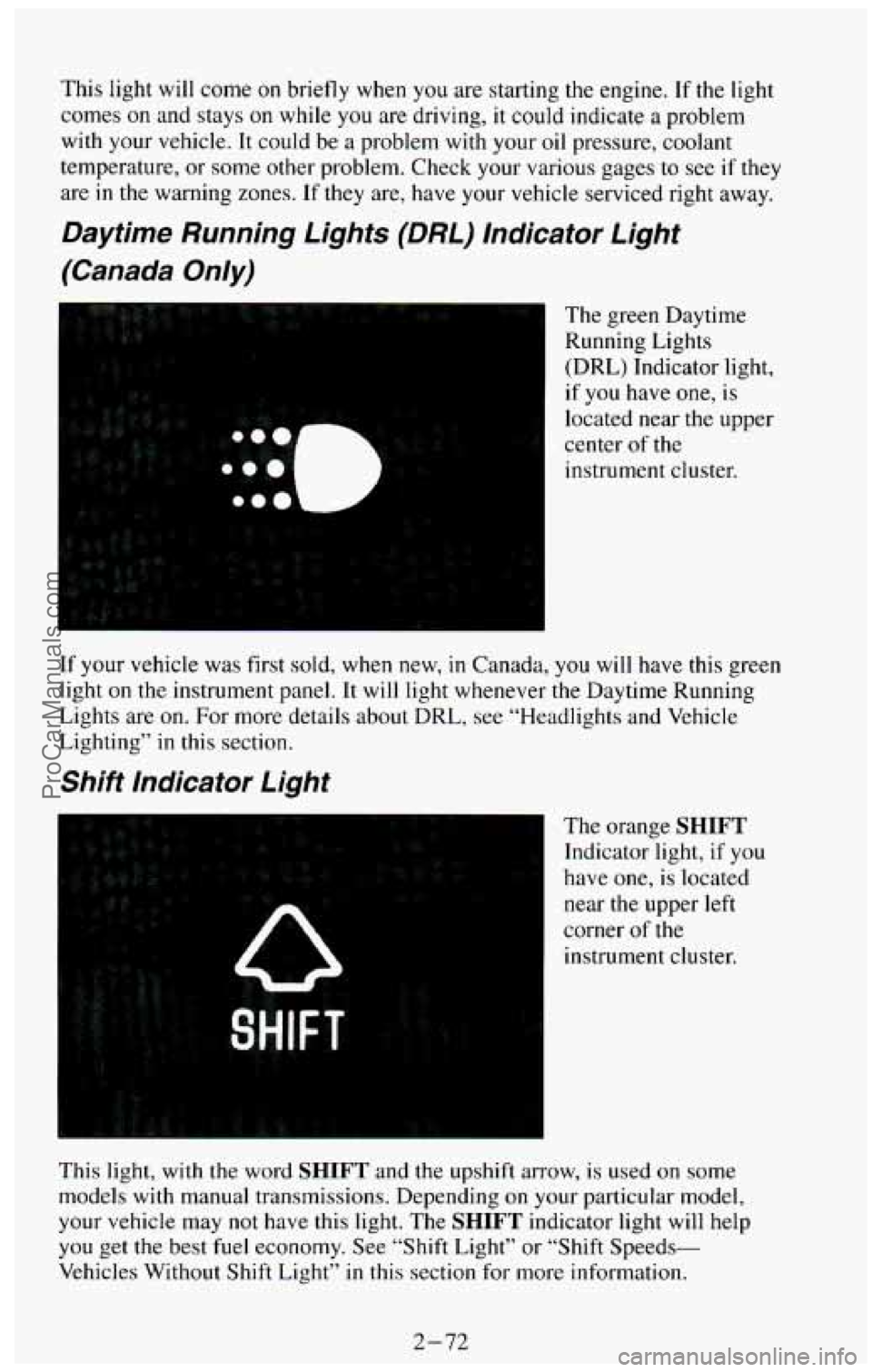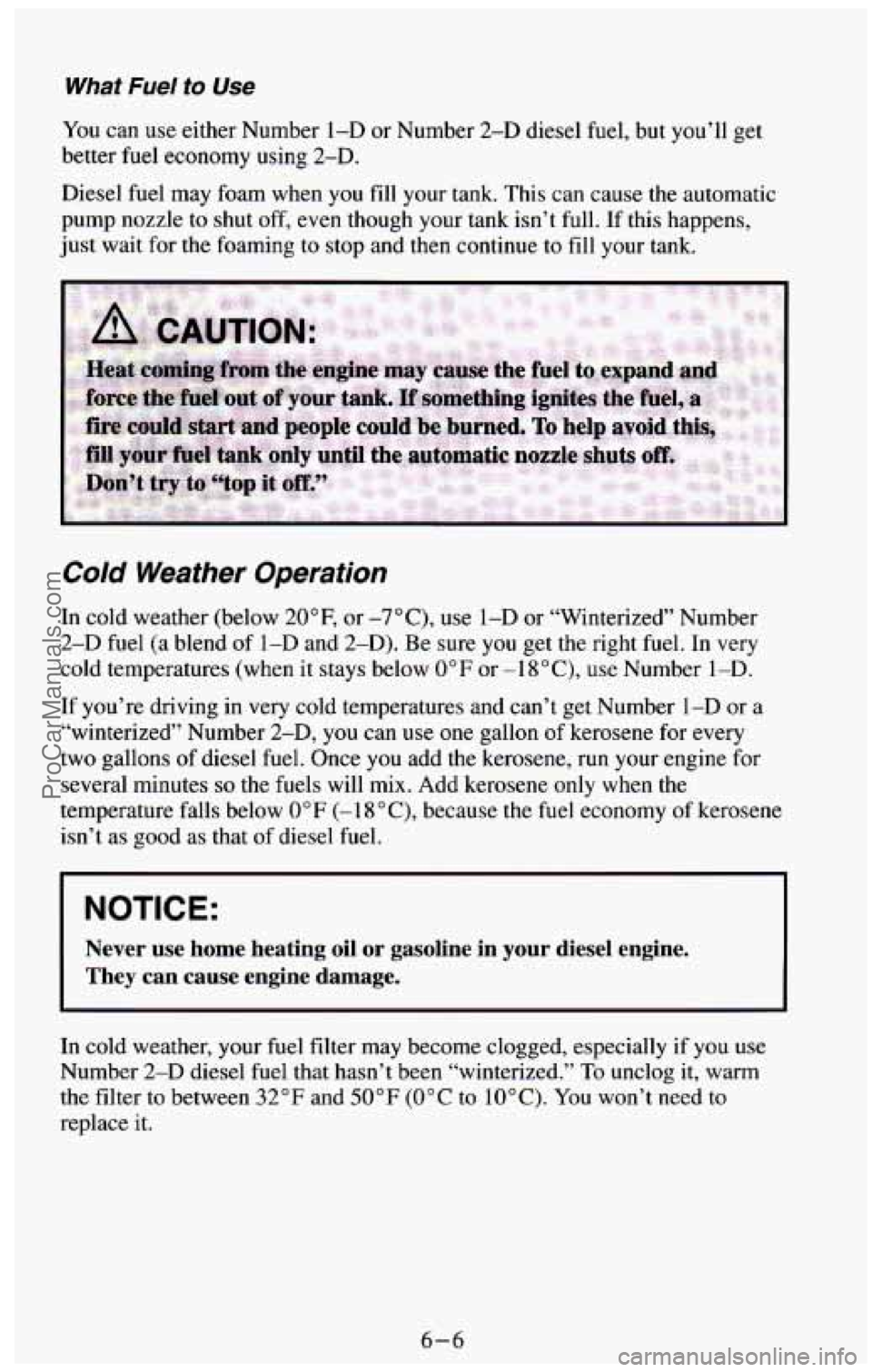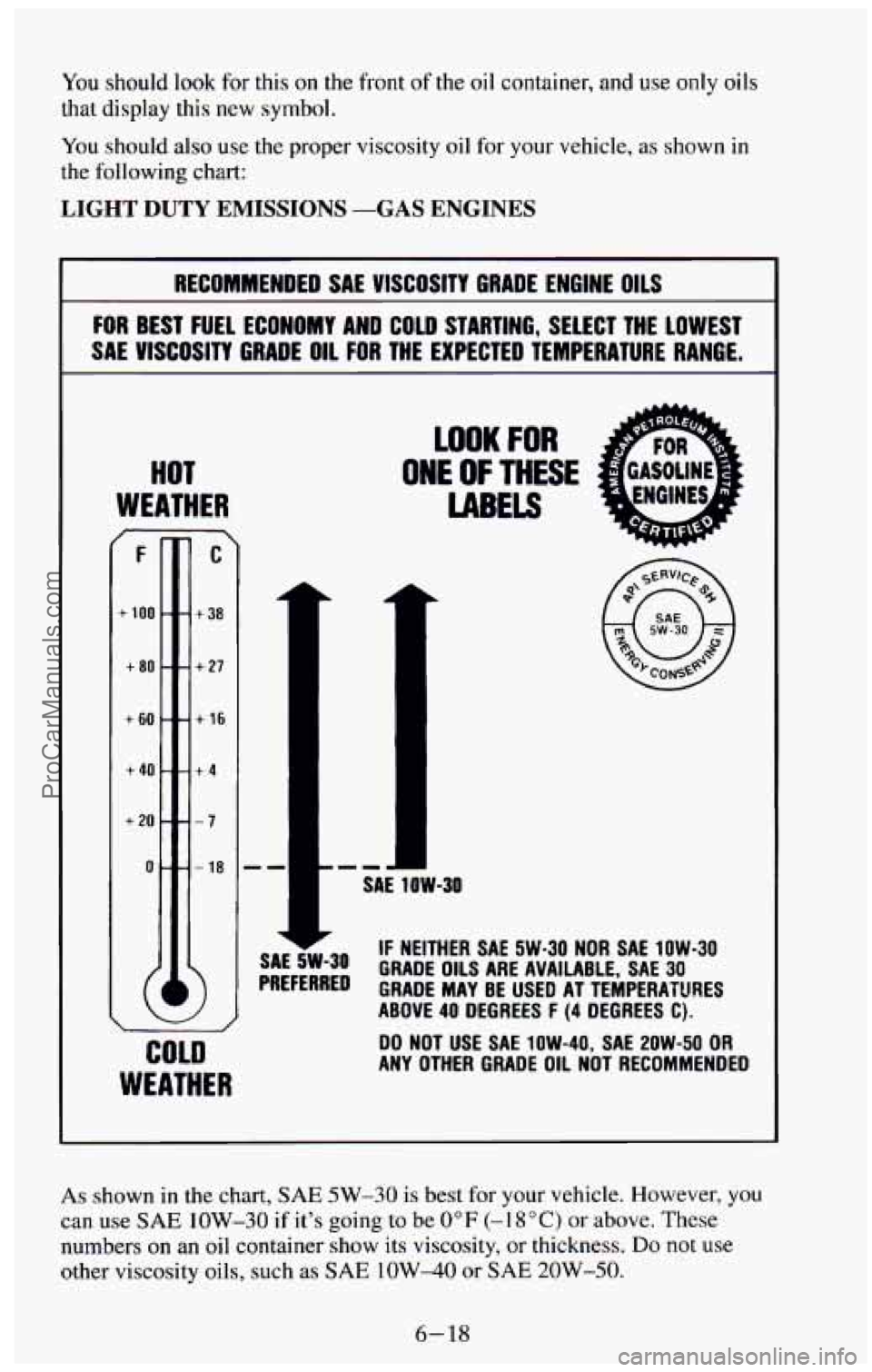Page 10 of 385
These symbols are on some of your controls:
I I Windshield Wiper
rl
i Rear Window
Washer Windshield
Washer Windshield
Defroster
1
3c
Rear
Window
Defogger Ventilating Fan
These symbols are used on
warning and indicator lights:
Engine Coolant
Temperature
BRAKE
I Brake
I p3
Baftery Charging
System
Fuel
ANTI-
I LOCK
I 4 Wheel
Anti-Lock
I RELEASE
Parking Brake Release
I\J
Rear Window Wiper
Hatch
Release
I
Engine Oil
Pressure
I SHIFT
1 Shift Light
ix
ProCarManuals.com
Page 72 of 385

3. If this light does not come on, or the instant the light goes off, turn your
ignition key to
START. When the engine starts, let go of the key.
NOTICE:
Holding your key in “Start” for longer than 15 seconds at a time
will cause your battery to be drained much sooner. And the
excessive heat can damage your starter motor.
4. If the engine does not start after 15 seconds of cranking, turn the
ignition key to
OFF. Wait one minute for the starter to cool, then try
the same steps again.
If you’re trying to start your engine after you’ve run out of fuel, follow the
steps
in “Running Out of Fuel” (see “Diesel Fuel Requirements and Fuel
System”
in the Index).
When your engine
is cold, let it run for a few minutes before you move your
vehicle. This lets oil pressure build up. Your engine
will sound louder when
it’s cold.
NOTICE:
If you’re not in an idling vehicle and the engine overheats, you
wouldn’t be there to see the coolant temperature gage. This
could damage your vehicle. Don’t let your engine run when
you’re not in your vehicle.
Cold Weather Starting (Diesel Engine)
The following tips will help you get good starting in cold weather.
Use
SAE low-30 oil when the outside temperature drops below freezing.
When the outside temperature drops below 0°F
(-I S’C), use your engine
coolant heater.
If
you park your vehicle in a garage, you shouldn’t need to use the coolant
heater
until the garage temperature goes below 0°F (-1 Sac), no matter how
cold
it is outside.
2- 17
ProCarManuals.com
Page 127 of 385

This light will come on briefly when you are starting the engine. If the light
comes
on and stays on while you are driving, it could indicate a problem
with your vehicle. It could be a problem with your oil pressure, coolant
temperature, or some other problem. Check your various gages to see
if they
are
in the warning zones. If they are, have your vehicle serviced right away.
Daytime Running Lights (DRL) Indicator Light
(Canada Only)
The green Daytime
Running Lights
(DRL) Indicator light,
if you have one,
is
located near the upper
center of the
instrument cluster.
If your vehicle was first sold, when new,
in Canada, you will have this green
light on the instrument panel. It will light whenever the Daytime Running
Lights are on.
For more details about DRL, see “Headlights and Vehicle
Lighting” in this section.
Shift Indicator Light
The orange SHIFT
Indicator light, if you
have one, is located
near the upper left
corner
of the
instrument cluster.
This light, with the word
SHIFT and the upshift arrow, is used on some
models with manual transmissions. Depending
on your particular model,
your vehicle may not have this light. The SHIFT indicator light will help
you get the best fuel economy. See “Shift Light” or “Shift Speeds-
Vehicles Without Shift Light”
in this section for more information.
2-72
ProCarManuals.com
Page 129 of 385
Oil Pressure Gage
Standard Cluster -Gas Standard Cluster -Diesel
40
Tachometer Cluster -Gas Tachometer Cluster -Diesel
The oil pressure gage shows the engine oil pressure in psi (pounds per
square inch) when the engine is running. Canadian vehicles indicate
pressure in
kPa (kilopascals). Oil pressure may vary with engine speed,
outside temperature and oil viscosity,
but readings above the low pressure
zone indicate the normal operating range.
2-76
ProCarManuals.com
Page 251 of 385

What Fuel to Use
You can use either Number 1-D or Number 2-D diesel fuel, but you’ll get
better fuel economy using
2-D.
Diesel fuel may foam when you fill your tank. This can cause the automatic
pump nozzle to shut
off, even though your tank isn’t full. If this happens,
just wait
for the foaming to stop and then continue to fill your tank.
Cold Weather Operation
In cold weather (below 20”F, or -7”C), use 1-D or “Winterized” Number
2-D fuel (a blend of 1-D and 2-D). Be sure you get the right fuel. In very
cold temperatures (when it stays below
0°F or -18”C), use Number 1-D.
If you’re driving in very cold temperatures and can’t get Number 1-D or a
“winterized” Number
2-D, you can use one gallon of kerosene for every
two gallons of diesel fuel. Once you add the kerosene, run your engine for
several minutes
so the fuels will mix. Add kerosene only when the
temperature falls below
0°F (-1 8 “C), because the fuel economy of kerosene
isn’t as good
as that of diesel fuel.
NOTICE:
Never use home heating oil or gasoline in your diesel engine.
They can cause engine damage.
In cold weather, your fuel filter may become clogged, especially if you use
Number 2-D diesel fuel that hasn’t been “winterized.” To unclog it, warm
the filter to between
32°F and 50°F (0°C to 10°C). You won’t need to
replace it.
6-6
ProCarManuals.com
Page 263 of 385

You should look for this on the front of the oil container, and use only oils
that display this new symbol.
You should also use the proper viscosity oil for your vehicle, as shown in
the following chart:
LIGHT DUTY EMISSIONS -GAS ENGINES
RECOMMENDED SAE VISCOSITY GRADE ENGINE OILS
FOR BEST FUEL ECONOMY AND COLD STARTING, SELECT THE LOWEST
SAL VISCOSITY GRADE OIL FOR THE EXPECTED TEMPERATURE RANGE.
HOT
WEATHER
F
+ 100 '
+80.
+60
+4a.
+20 -
0-
C
- +38
. +27
-+16
.+4
'-7
- 18
I
SAE SW-30
PREFERRED
LOOK FOR
ONE OF THESE
LABELS
SAE 1OW-30
IF NEITHER SAE 5W-30 NOR SAE 1OW-30
GRADE
OILS ARE AVAILABLE, SAE 30
GRADE MAY BE USED AT TEMPERATURES
ABOVE
40 DEGREES F (4 DEGREES C).
DO NOT USE SAE 1OW-40, SAE 2OW-50 OR
ANY OTHER GRADE OIL NOT RECOMMENDED
As shown in the chart, SAE 5W-30 is best for your vehicle. However, you
can use SAE 1OW-30 if it's going to be 0°F (- 1 8 O C) or above. These
numbers on
an oil container show its viscosity, or thickness. Do not use
other viscosity oils, such as SAE 1OW-40 or SAE 20W-50.
6-18
ProCarManuals.com
Page 264 of 385
HEAVY DUTY EMISSIONS -GAS ENGINES
RECOMMENDED SAE VISCOSITY GRADE ENGINE OILS
FOR BEST FUEL ECONOMY AND COLD STARTING, SELECT THE LOWEST
SAE
VISCOSITY GRADE OIL FOR THE EXPECTED TEMPERATURE RANGE.
HOT
WEATHER
"F "C
+loo - - +38
+80 --+27
+60 - - +16
t40--+4
+20 ---I
0 - --18
LOOK FOR
ONE OF THESE
LABELS
I
I
SAE 1OW-30
PREFERRED
SAE
5W-30
COLD
WEATHER
IF NEITHER SAE 5W-30 NOR SAE 1OW-30
GRADE OILS ARE AVAILABLE, SAE 30
GRADE MAY BE USED AT TEMPERATURES
ABOVE
40 DEGREES F (4 DEGREES C).
ANY OTHER GRADE OIL NOT RECOMMENDED
DO
NOT USE SA€
1OW-40, SAE 2OW-50 OR
As shown in the chart, SAE IOW-30 is best for your vehicle. However, you
can use SAE 5W-30 if it's going to be colder than 60°F ( 16°C) before your
next oil change. When it's
very cold, you should use SAE 5W-30. These
numbers on
an oil container show its viscosity, or thickness. Do not use
other viscosity oils, such as SAE lOW-40 or SAE 20W-50,
6-19
ProCarManuals.com
Page 270 of 385
DIESEL ENGINES
I RECOMMENDED SAE VISCOSITY GRADE ENGINE OILS
SELECT THE SAE GRADE 011 BASED ON
THE EXPECTED TEMPERATURE RANGE
I BEFORE NEXT OIL CHANGE
HOT
WEATHER
+loo -
+60 - - +16
+32 -- 0
0 - - -18
-20 - - -29
________
COLD
WEATHER
LABEL
SAE 1OW-30
SAE 15W-40
PREFERRED
above 0°F (-18%)
- SAE r 30
DO NOT USE SAE 1DW-40, SAE 2OW-50 OR
ANY OTHER GRADE OIL NOT RECOMMENDED
SAE 15W-40
As shown in the viscosity chart, SAE 15 W-40 is best for your vehicle.
However, you can use
SAE low-30 if it’s going to be colder than
32°F (0°C) before your next oil change. When it’s very cold, below
0°F (-1 8”C), you should use SAE IOW-30 to improve cold starting.
Also, SAE 30 may be used at temperatures above freezing, 32°F (0°C).
These numbers on the oil container show its viscosity, or thickness. Do
not use other viscosity oils such as SAE 10W-40 or SAE 20W-50.
6-25
ProCarManuals.com